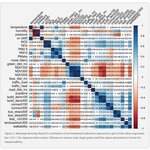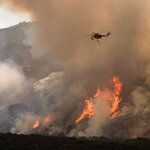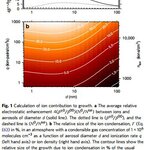Atmospheric

Space weather and its changes to earth's magnetic fields has an outsized impact in Arctic regions through effects on electricity networks, mining operations and shipping.
A new technique called Fractional Derivative Rate (FDR) published in Space Weather has been used for analyzing fluctuations in the Earth’s magnetic field and found dramatic differences at different latitudes and different times of day.
The northernmost stations were more geomagnetically active at midday, while the activeness at the southernmost stations was highest at midnight. The largest differences between different…

As I write this, our local school is closed due to concern about smoke inhalation. Other parts of the nation may not realize it but two severe wildfires broke out recently, in northern and southern California. If this had happened anywhere near New York City or Washington, D.C. it would be called Smokemageddon, or a Particulate Vortex, or something else clever, but because it's California we won't get Lester Holt in a facemask and 24 hour coverage on CNN.
Though California is a large state, the effect is always widespread when these happen, and these happen a lot. (1) Even 100 miles away the…

As the scale and impacts of climate change become increasingly alarming, meat is a popular target for action. Advocates urge the public to eat less meat to save the environment. Some activists have called for taxing meat to reduce consumption of it.
A key claim underlying these arguments holds that globally, meat production generates more greenhouse gases than the entire transportation sector. However, this claim is demonstrably wrong, as I will show. And its persistence has led to false assumptions about the linkage between meat and climate change.
My research focuses on ways in which animal…

Beer, the most popular alcoholic drink in the world, consumes around 17% of global barley production, but this share varies across major beer-producing countries; 83% in Brazil to 9% in Australia.
What if global warming hits and temperatures rise more than 0.1 Celsius that has happened so far? Less barley, less beer. The vulnerability of beer supply to such extremes has never been assessed but a new estimate is sure to spur action, at least if you believe in estimates.
Climate change estimates predict a tange of frequency and severity of drought and heat extremes and a new computer model…

Christmas tree farms don't cause global warming, according to European Union politicians, and that is why Europeans have decided to meet their emissions targets by...burning wood.
You read that right, they have decided to burn more wood to offset the increases in emissions they have caused by closing nuclear plants. Their logic is that wood is renewable. Christmas tree farms prove it. And when they created the international emissions framework they intentionally exempted wood, as long as it was imported.
Renewable energy sounds great but reframing burning wood as renewable even though it…

In countries that have embraced centralized energy and migrated away from individual cooking with dung or wood, both public health and the emissions have improved. So why not pay for all developed countries to switch? The World Bank wanted to do that half a decade ago but it became political; countries like the U.S. agreed only to contribute if they used solar or wind, which are not viable even in America much less in a poor nation. It was another case of wealthy countries with plenty of energy passing their guilt along to Africa and Asia.
A new analysis presented at the European Society of…

Urban poor people live in areas where there is more population density and higher pollution and more crime, that is no surprise. But pollution is relative in 2018, American air is so incredibly clean(1) that epidemiologists and activists have tried to define harmful smog all the way down to 2.5 μm (microns) in diameter in hopes of showing air quality is still a worry.
Particles to small you need an electron microscope to know they exist. Yet they try to same it is th same as real smog, an actual carcinogen.
Now they have also begun to consider noise the same as smog for harm, along…

Historically, large atmospheric events like fires and volcanic eruptions have had cooling effects. It is the 200th anniversary of Mary Shelley's "Frankenstein", for example, part of which was inspired by the gloom from a volcanic eruption that led to 'a year without a summer' in Europe of 1816.
Fires and other events cause the release of soot and other aerosols to be released which can cool the planet by reflecting sunlight back into space and increasing cloud brightness. A new study finda that such a cooling effect on the planet may have been significantly underestimated by previous…

Five years ago, California set out to be a world leader in adopting ambitious greenhouse gas reduction targets and created the world's fourth-largest carbon-trading program. Not bad for one state.
Except it isn't helping the state, it is subsidizing others. And some of the emissions targets are not emissions at all, they are instead epidemiological claims like small micron particulate matter (PM2.5), which have had zero acute deaths but were the target of EPA and California environmentalists despite a lack of evidence.
Under cap-and-trade, California businesses get trade-able emissions…

Cosmic rays from supernovae can influence Earth´s cloud cover and how that influences climate could be useful for making better models.
A new study shows how atmospheric ions, produced by the energetic cosmic rays raining down through the atmosphere,help the growth and formation of cloud condensation nuclei – the seeds necessary for forming clouds in the atmosphere. When the ionization in the atmosphere changes, the number of cloud condensation nuclei changes affecting the properties of clouds.
More cloud condensation nuclei mean more clouds and a colder climate, and vice-versa.
Since clouds…